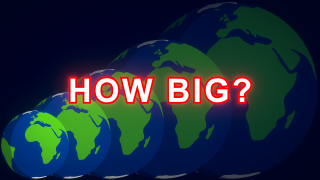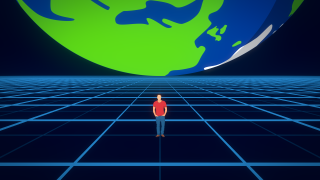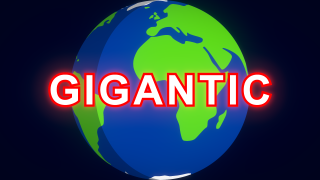The Earth is GIGANTIC
Published: July 30, 2024 at 12:07 PM (PT)
5:56
(10680 frames/30fps) Resolution:1920x1080
(FHD) Most Rewatched:2:45 to 3:10 Realtime Statistics...
30 Minutes...
Hour...
24 Hours...
Information Sources
https://blendertimer.com/factsheets/solar-system/planet-factsheet
Burj Khalifa Factshttps://www.burjkhalifa.ae/en/the-tower/facts-figures
Cruising Altitude of Airlinershttps://en.wikipedia.org/wiki/Cruise_(aeronautics)
Kármán Linehttps://en.wikipedia.org/wiki/K%C3%A1rm%C3%A1n_line
ISS Informationhttps://www.nasa.gov/reference/international-space-station
Mount Everest Factshttps://en.wikipedia.org/wiki/Mount_Everest
Speed of Soundhttps://blendertimer.com/web-tools/speed-of-sound-calculator
Your Weight is Less at the Equatorhttps://www.wtamu.edu/~cbaird/sq/2014/01/07/do-i-weigh-less-on-the-equator-than-at-the-north-pole
Earth Factshttps://en.wikipedia.org/wiki/Earth
World Populationhttps://www.worldometers.info/world-population
Size of a Grain of Sand (2)N/A (real world measurement of ~0.5 millimeters)
Single Story House Heighthttps://www.gigacalculator.com/articles/how-tall-is-a-normal-house-inside-outside
Grand Canyon Factshttps://en.wikipedia.org/wiki/Grand_Canyon
Height of a Lightbulbhttps://blendertimer.com/web-tools/compare-size?186
Trash Bin Heighthttps://www.wm.com/location/arizona/az/_documents/Recycling-Containers.pdf
Moon Factsheethttps://nssdc.gsfc.nasa.gov/planetary/factsheet/moonfact.html
Empire State Building Factshttps://www.esbnyc.com/about/facts-figures
NASA Sun Factsheethttps://nssdc.gsfc.nasa.gov/planetary/factsheet/sunfact.html
Graphic Sources
https://pixabay.com/vectors/earth-planet-space-terrestrial-8233221
Mount Everest (Daniel Roberts)https://pixabay.com/vectors/mount-everest-mountain-nature-8297059
Man Walking-Side (Daniel Roberts)N/A
Yellow Car (Daniel Roberts)https://www.alamy.com/just-an-orange-car-image471694088.html
Airliner (Daniel Roberts)https://pixabay.com/vectors/airliner-airplane-flying-plane-8886817
Sound Icon (Daniel Roberts)N/A
Man Standing-Front (Daniel Roberts)https://pixabay.com/vectors/person-man-stand-human-arms-legs-8238232
Giraffe (Daniel Roberts)https://pixabay.com/vectors/giraffe-animal-nature-wild-8204924
Pond (Daniel Roberts)https://pixabay.com/vectors/pond-nature-lake-water-trees-7866335
Rocks (Daniel Roberts)https://pixabay.com/vectors/rocks-grass-stone-boulder-nature-8897263
Water Drop (Daniel Roberts)https://pixabay.com/vectors/water-drop-liquid-fluid-nature-8904702
Snail (Daniel Roberts)N/A
Deserted Building (Daniel Roberts)https://pixabay.com/vectors/building-deserted-brick-fallen-7695849
Coronavirus (Daniel Roberts)N/A
Grain of Sand (Daniel Roberts)https://pixabay.com/vectors/sand-grain-particle-nature-small-8316168
House (Daniel Roberts)https://pixabay.com/vectors/house-building-architecture-modern-8886816
Grand Canyon (Daniel Roberts)https://pixabay.com/vectors/grand-canyon-valley-mountains-8886819
Burj Khalifa (Daniel Roberts)https://pixabay.com/vectors/burj-khalifa-dubai-building-tall-8207549
Lightbulb (Daniel Roberts)https://pixabay.com/vectors/lightbulb-light-bulb-electric-8897265
Trash Bin (Daniel Roberts)https://pixabay.com/vectors/recycle-bin-trash-can-garbage-8897264
The Moon (Daniel Roberts)https://pixabay.com/vectors/moon-earth-space-natural-satellite-8236211
Empire State Building (Daniel Roberts)https://pixabay.com/vectors/empire-state-building-building-city-7845819
The Sun (Daniel Roberts)https://pixabay.com/vectors/sun-star-space-solar-light-bright-8328084
Audio Sources
N/A
To the Galaxy (Daniel Roberts)https://pixabay.com/music/ambient-to-the-galaxy-10734
Hit-3 (Daniel Roberts)N/A
Object Flyby (Daniel Roberts)https://pixabay.com/sound-effects/object-flyby-8115
Cyber Space-Synthesized (Daniel Roberts)https://pixabay.com/sound-effects/cyber-space-synthesized-108865
Electric Iris (Daniel Roberts)N/A
Retract1 (Daniel Roberts)N/A
Escape of Triumph-Epic Cinematic (Daniel Roberts)https://pixabay.com/music/suspense-escape-of-triumph-epic-cinematic-127029
Rumble-1 (Daniel Roberts)N/A
Pop2 (Daniel Roberts)N/A
Wind-2 (Daniel Roberts)N/A
Match Ignite (Daniel Roberts)https://pixabay.com/sound-effects/match-ignite-165316
Airplane (Daniel Roberts)N/A
Fast-Hit-2 (Daniel Roberts)N/A
Wind (Daniel Roberts)https://pixabay.com/sound-effects/wind-13850
Revolution-Epic Cinematic (Daniel Roberts)https://pixabay.com/music/main-title-revolution-epic-cinematic-111025
Hit Bang-3 (Daniel Roberts)N/A
Hit Bang-4 (Daniel Roberts)N/A
Hit and drag-10 (Daniel Roberts)N/A
Rise of the Enemy (Daniel Roberts)https://pixabay.com/music/main-title-rise-of-the-enemy-full-2-09-14302
The Earth is gigantic. But no
one really seems to understand
just how gigantic it really is.
This often leads to all sorts
of strange convoluted ideas about
what the Earth looks like and
how it works.
The diameter of Earth is around
12,742 kilometers or 7,918 miles
making a circumference of 40,030
kilometers or 24,874 miles. But
there's a big problem...what does
this even mean? Who even knows
what 40 thousand kilometers is?
It's a large number...and that's
about where it ends.
But, fortunately, the video
does not end here because the
Earth is gigantic more than you
can believe.
But in order to get a better
idea about the scale of the Earth,
we're going to need to increase
our dimensions.
This is any average person standing
on the Earth near sea level. Looking
across the Earth at eye level
you'll see something like this.
From this perspective it is impossible
to get any idea of how big the
Earth is other than just "big".
But maybe removing some of the
visual obstacles will help. Eh,
that still looks pretty flat.
Well anyway, if we ascend to the
tops of the trees...it looks pretty
much the same. Even at the very
top of the Burj Khalifa (the tallest
building in the world), there's
not much more to see, with the
exception of a few distant mountains.
Ascending to the tops of the mountains...
there's still no clear reference
for the size of the Earth. Even
removing the visual obstacles
for a clear view of the horizon,
the curvature is minimal. I think
it's clear at this point that...
the Earth is rather large. Ascending
to the cruising altitude of airliners,
the Earth still looks remarkably flat.
But this should come as no surprise
for the reason that...the Earth's
design is absolutely gigantic.
At 100 kilometers (the border
of space), the curvature is now
quite visible. But even in space
the Earth appears to extend on
for quite some time. Likely because
it's gigantic. Anyway, if we ascend
to over four times this altitude,
we'll find the International
Space Station. At this point,
we can clearly see the curvature
of the Earth. But, even four times
farther than the edge of space
you can still only see a small
section of the Earth. Here's the
thing, though. We're 4 times farther
than the border of space but,
if we take a bit more than a step
back, we can see that we aren't
actually that far above the Earth.
It almost looks as if we're only
a few dozen kilometers above the
Earth, not several hundred. Looking
at the cruising altitude of airliners
from this perspective, it's easy
to see why the Earth was looking
so flat when we were at that altitude.
Viewing the entire Earth certainly
gives a different perspective!
Speaking of viewing the entire Earth.
This is Mt. Everest. Oh what,
you don't see it? Well...it's
right here. Not like...in the
real world but I mean like...that's
where it is here...or...I mean
it's not like actually...
Even viewing it in 8k you can
barely see it! And, in reality,
it'd be even more difficult to see Mt.
Everest because of all the other
mountains surrounding it.
And, while we're looking at
the entire Earth, we might as
well try traveling around it.
Walking around the Earth would
take a full year. Obviously ignoring
the water and whatever other obstacles
you may encounter. Driving around
the Earth at standard highway
speeds would take around 2 weeks
of continuous driving. Again ignoring
any obstacles. Flying around the
Earth in an airliner would take
2 full days. Even traveling around
the Earth at the speed of sound
would take 32 hours! But you might
actually be traveling faster than
this right now!
The Earth is so large that,
despite taking nearly 24 hours
to make one full rotation, anyone
near the equator will be traveling
1674 kilometers per hour or Mach 1.3!
Well except that the Earth is
also orbiting the Sun and the
Sun is orbiting the Milkyway and the...
But at least the air is moving
along with you so that you're
not being faced with supersonic winds.
Oh and, fun fact, because of the
Earth's spin and its shape you
actually weigh less at the equator
than at the poles. Your mass is
still the same, it's just your
weight is less. But the change
in weight is very negligible,
so you'll likely never know.
Anyway, Earth has a surface
area of 51 billion hectares. This
means that if every person on
the Earth were spaced out with
equal distances from everyone
else, each person would have over
6 hectares entirely for themselves!
Well except nearly 71% of Earth
is covered with water. But, even
only counting the surface area
of the land, each person would
have over 1.8 hectares all to
themselves. Well...and probably
some animals, trees, rocks, and
whatever else.
Ok, but let's try scaling everything
down a bit. If you were half the
height of a grain of sand, the
Earth would be about the height
of 450 houses or about the depth
of the Grand Canyon or more than
twice the height of the Burj Khalifa!
Speaking of the Burj Khalifa,
at this scale, the Burj Khalifa
would be about the height of a
lightbulb. Mt. Everest would be
only a little taller than a trash bin.
And, despite many people thinking
the moon isn't nearly as big as it is.
At this scale, the Moon would
be taller than the Empire State
Building. Remember, you are half
the height of a grain of sand.
Oh, and the Sun at this scale
would extend two times farther
than the edge of space!


 July 30, 2024
July 30, 2024 July 30, 2024
July 30, 2024